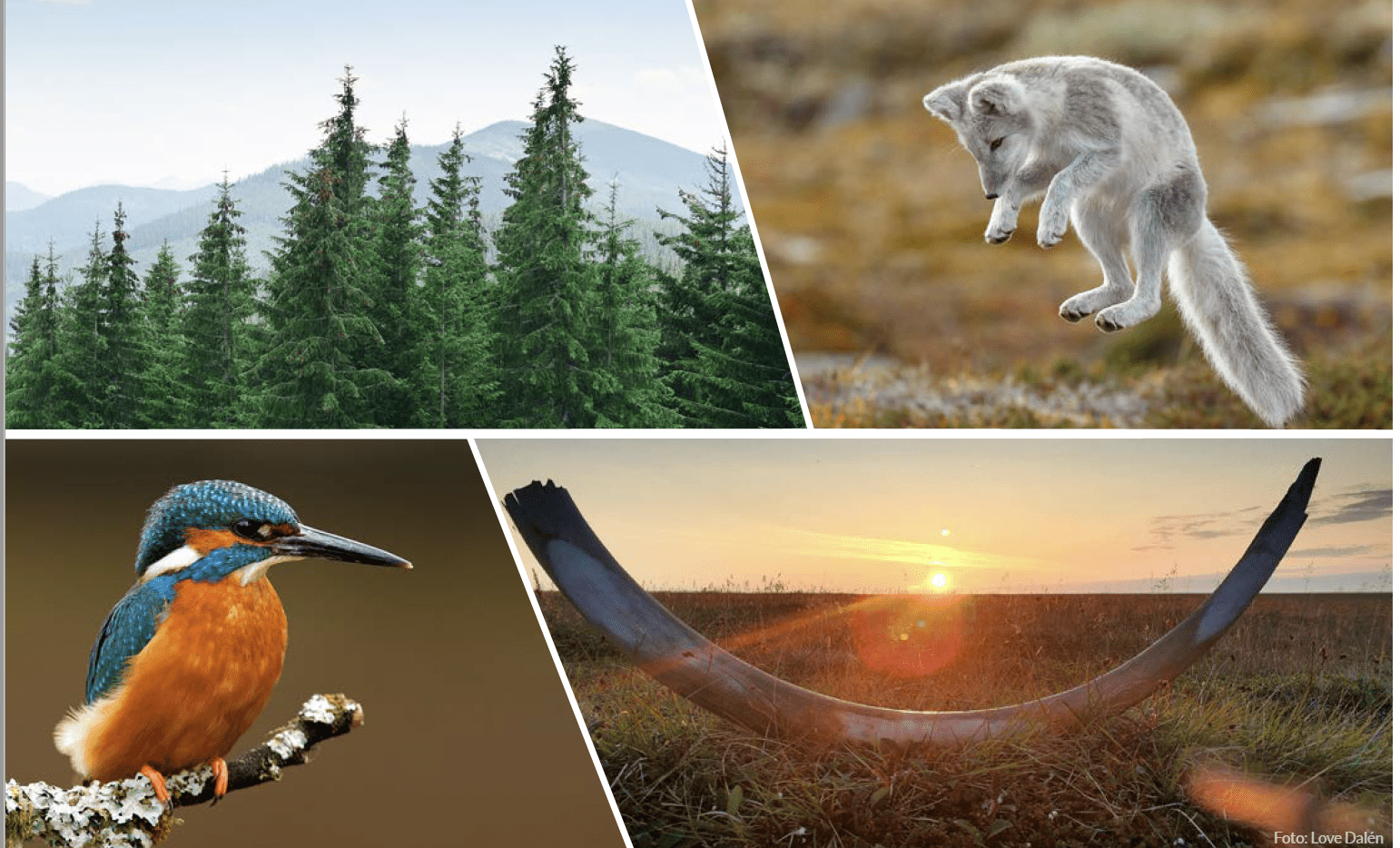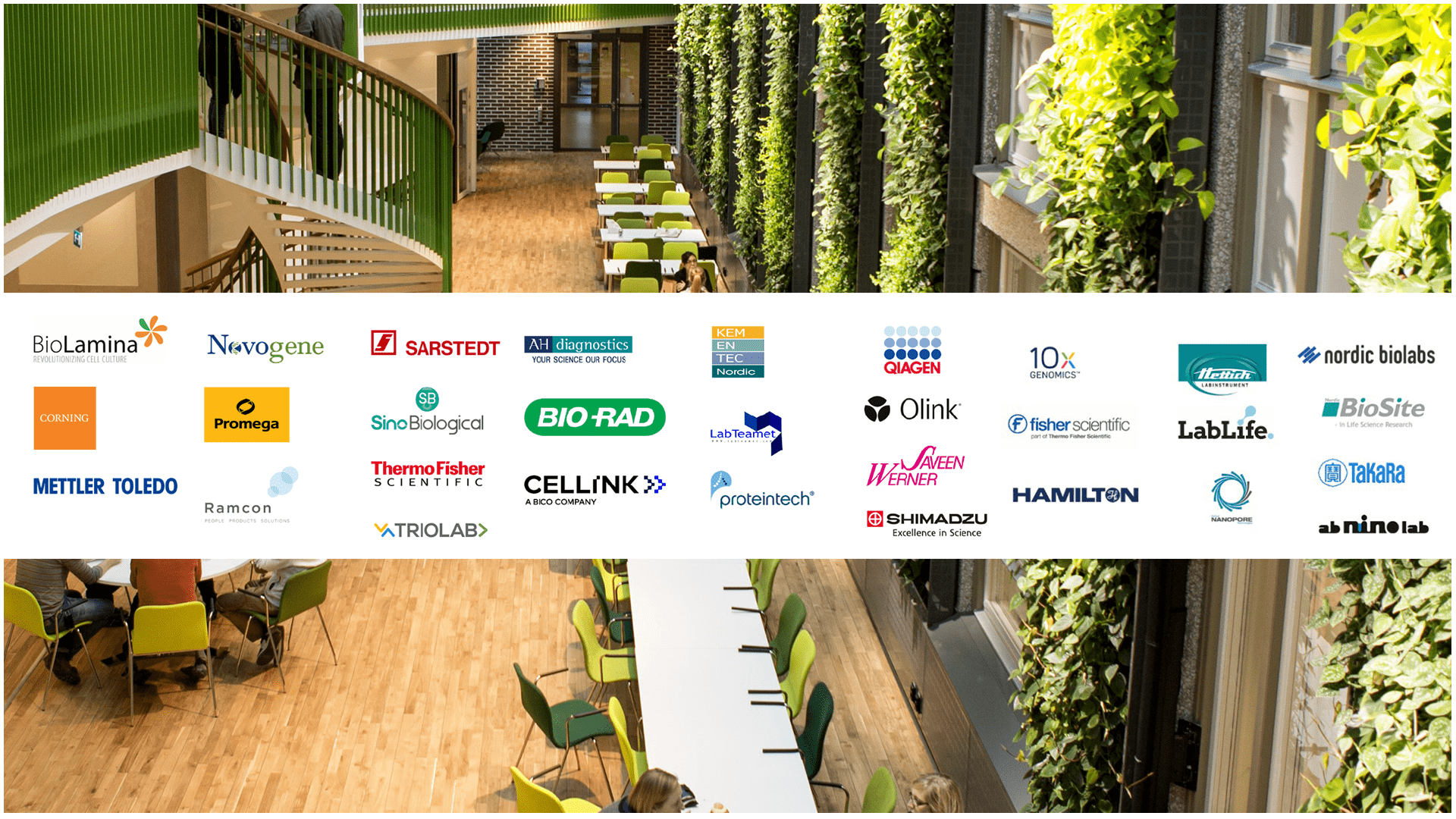SciLifeLab Science Summit 2023
September 20 @ 09:00 – 17:00 CEST

Genomics of Biodiversity and Evolution
In an era characterized by extinction and habitat loss, it is crucial to explore biological diversity on our planet and understand the evolutionary processes that generate it. Genome sequencing has generated numerous insights into how species form and how they adapt to their environments, which is vital to understand in a changing world. As sequencing technologies improve and become less expensive it becomes feasible to produce high-quality genome assemblies and analyze genetic diversity in a huge number of species, which has led to a number of ambitious projects including the Earth BioGenome Project to sequence all known Eukaryotes.
Swedish scientists and SciLifeLab are at the forefront of this field, with genome projects including spruce, herring, Arctic fox and 240 mammals, advancing knowledge of topics including population genetics, adaptation, speciation, convergent evolution, and functional constraint.
In this SciLifeLab Science Summit, we have gathered several leading researchers who use genomics to learn about the diversity of life!
We invite you to Stockholm and Aula Magna for a full-day conference program with ample time for discussions, mingling, and networking.
This event is open to anyone interested in the topic and is free of charge.
Registration closed If you are interested in participating, please send an email to events@scilifelab.se.
Poster session, Flash Talk & Best Poster Award
Registration opens at 08:45. Please hang your poster on the poster boards upon arrival and in time before the Conference starts at 09:30. Pins are available. There are two poster sessions. Please remove your poster from the poster board after the second session or at 17:00. Any remaining posters after 17:15 will be discarded. The Scientific Committee´s Poster jury will nominate the Science Summit 2023 Best Poster and award the winner a 5 000 SEK Travel Grant. You must stay for the prize ceremony at the end of the conference.
Four (4) submitted poster abstracts will be selected for Flash Talks à 5 minutes on stage.
The selected Flash Talks speakers are
Cynthia Perez Estrada. Three-dimensional genome architecture persists in a 52,000-year-old woolly mammoth skin sample
Patrik Rödin Mörch. The Role of Population History in Shaping the Mutational Load of Structural Variants Relative to SNPs, in Distinct Island versus Continental Lagopus Lineages
Andreas Wallberg. New insights into the evolutionary history and adaptive potential of World Ocean krill using comparative population transcriptomics
Qiaoling Deng. Genetic parallelism and adaptation to brackish water bodies in sprat (Sprattus sprattus) and Atlantic herring (Clupea harengus)
Important dates
Sept 1. Registration deadline for posters! Poster submission closes, and the selection of Flash Talks will be made.
Sept 4. Poster submission approval email.
Sept 11. Invitation email to selected Flash talk speakers.
Sept 11 at 12:00. Registration for the SciLifeLab Science Summit closes
Sept 11. Poster Abstracts published as a PDF on the website
Free bus transportation
We offer free bus transportation from Uppsala (BMC Campus) at 08:00 to Aula Magna, (SU Campus Frescati) in the morning and back after the Conference at 17:00 and after the mingle at 18:30. Reserve your seat when filling in the registration form.
Satellite Symposium:
Computational Methods in Evolution and Biodiversity
On September 21, the Data-Driven Life Science Expert group invites you to a full-day satellite symposium and workshop, “Computational Methods in Evolution and Biodiversity“
Speakers
- Leif Andersson, Uppsala University, SWE
- Richard Durbin, Wellcome Sanger Institute, UK
- Tom Gilbert, University of Copenhagen, DK
- Elinor Karlsson, University of Massachusetts Medical School & Broad Institute, USA
- Karin Norén, Stockholm University, SWE
- Karin Rengefors, Lund University, SWE
- Tanja Slotte, Stockholm University, SWE
- Tom van der Valk, Swedish Museum of Natural History, SWE
Please, see the abstracts below the Program
Program
| 08:00 | Bus from BMC Uppsala to Aula Magna |
| 08:45 | Registration and coffee, hanging posters |
| 09:30 | Welcome Words Ylva Engström, Chair of the SciLifeLab Board Introduction to the Conference Kerstin Lindblad-Toh, Chair of the Scientific Committee |
| Session I: Moderator Kerstin Lindblad-Toh | |
| 09:45 | Investigating mammalian evolution and human disease through comparative genomics in hundreds of species Elinor Karlsson, UMass Chan Medical School and Broad Institute, USA |
| 10:15 | A Million-Year-Old Journey: Exploring Mammoth Speciation and Adaptive Evolution through time Tom van der Valk, Swedish Museum of Natural History |
| 10:40 | Coffee break and Poster session I |
| Session II: Moderator Leif Andersson | |
| 11:20 | Insights from high quality genome sequencing across the tree of life Richard Durbin, University of Cambridge, UK |
| 11:55 | Conservation genomics of the Scandinavian Arctic fox Karin Norén, Stockholm University |
| 12:20 | Lunch break and mingle, exhibitions |
| Session III: Moderator Love Dalén | |
| 13:40 | Domestication hologenomics – what are we missing without taking this approach? Tom Gilbert, University of Copenhagen, DK |
| 14:15 | Sequencing the supergene that governs Darwin’s different forms of flowers Tanja Slotte, Stockholm University |
| 14:40 | Flash Talks from Junior researchers (selected from submitted abstracts) 5-minute talk/researcher |
| 15:05 | Coffee break and Poster session II |
| Session IV: Moderator Matthew Webster | |
| 15:45 | The remarkable population structure of Atlantic and Baltic herring – selection, selection, selection Leif Andersson, Uppsala University |
| 16:20 | Why cyanobacterial blooms produce toxins – unravelling the underlying genetic diversity in the microcystin gene cluster Karin Rengefors, Lund University |
| 16:45 | Best Poster Award ceremony Closing words |
| 17:00 | End of Conference Meet the speakers and mingle; snacks and free beverages Bus to Uppsala departs at 17:00 and at 18:30 |
Speaker abstracts
Initial genetic studies with a handful of neutral markers revealed no genetic differentiation among populations of Atlantic herring, not even between Atlantic and Baltic herring classified as distinct subspecies by Linnaeus. Whole genome sequencing has totally changed the picture. Atlantic herring can now be divided into many subpopulations (ecotypes). It is an adaptive radiation with incomplete reproductive isolation between ecotypes. We find strong genetic differentiation at loci under selection but minute genetic differentiation at neutral loci. The explanation for this is the huge population sizes minimizing drift, high fecundity allowing effective selection, a homing behavior but with gene flow. Herring is a broadcast spawner and it is probably no strong selection for prezygotic reproductive isolation. Ecological adaptation in Atlantic herring is related to a diversity of environmental conditions including salinity, temperature and light conditions as well as behavioral traits such as timing of reproduction and migration. Recently we used SNP-chip analysis to explore the population structure of Baltic herring in the Bothnian Sea. This analysis revealed two major subgroups: spring- and autumn-spawning Baltic herring. However, a third genetically distinct population was present among the spring-spawners. This ecotype had a three-fold larger body size than other populations spawning in the same area at the same time implying a marked difference in feeding behavior. This illustrates the adaptive differentiation occurring in the herring. The results have important implications for fishery management of the herring in the Baltic Sea and elsewhere.
Dr. Leif Andersson is a specialist in genetics and genome biology. He and his group have made ground-breaking studies on the relationship between genetic and phenotypic variation. He has been working on comparative genomics using domestic animals as models for phenotypic evolution. This has resulted in discoveries of genotype-phenotype relationships such as mutations affecting pigmentation, gaits in horses, comb morphology in chickens and muscle growth in pigs. He has also studied the genetic basis for domestication of rabbits, chickens and pigs. The research program has been expanded to natural populations as exemplified by studies of the evolution of Darwin’s finches and their beaks, a supergene controlling male mating strategies in the ruff and genetic basis of ecological adaptation in Atlantic herring. Leif Andersson is professor in Functional Genomics at Uppsala University and in Animal Genomics at Texas A&M University. He was awarded the Wolf prize in Agriculture 2014.
I will discuss progress in scaling up the generation of high quality reference genome sequences, and some of the insights that we have obtained from them. Using high accuracy PacBio CCS reads and paired end Illumina Hi-C data we are now obtaining essentially complete, high contiguity chromosomal assemblies at an increasing rate and decreasing cost, with more than a thousand assemblies completed within the Tree of Life programme at the Wellcome Sanger Institute. Because in most cases even heterochromatic repeat DNA is well assembled, we have been able to characterise turnover of centromere-associated repeates which are some of the most rapidly evolving seqence in the genome, observing repeated transitions in plants between satellite tandem repeats and transposon cluster patterns. Furthermore, by selection of very high confidence bases from the individual CCS sequencing reads, we are able to identify signatures of somatic mutations across a very wide range of species, suggesting previously unobserved mutational processes.
Richard Durbin works in computational genomics. He has been leader or co-leader of multiple large collaborative projects, including the 1000 Genomes Project, and more recently has worked on genome assembly and contributed to the Vertebrate Genomes Project and the Earth Biogenome Project. He has also introduced multiple bioinformatic methods and data structures, including bwa for read mapping and the BAM format for genomic data, and worked on evolutionary genomics in non-model vertebrate systems, and understanding human history from ancient and modern DNA data. Richard is a Fellow of the Royal Society of London (2004), a Member of EMBO (2009) and a Foreign Member of the American Academy of Arts and Sciences (2019).
Analyses that compare the genomes of contemporary domestic animals and plants with those of their wild relatives have provided a wealth of insights into not only when and where our ancestors started the process, but also what specific genetic variants are key to modern phenotypes. Furthermore, once coupled to palaeogenomic data, such datasets can also even reveal the order in which such variants arose, shedding further insights into the process itself. However while there is no doubt that we have learnt much about domestication in general, and indeed for most domestic species we can clearly document the genetic basis of why the end product differs from the start, I argue that there may be certain processes that were involved that have been largely overlooked, in particular related to the so-called hologenome.
Tom Gilbert is Professor of Palaeogenomics at the University of Copenhagen, Professor II at NTNU University Museum, and Director of the DNRF Center for Evolutionary Hologenomics. He holds a PhD in the study of ancient DNA from the University of Oxford, and has been active in both trying to develop methods to both expand the potential of ancient DNA to our understanding of the past, as well as more recently leading research aimed at revisiting our understanding of ecological and evolutionary processes using hologenomic techniques – ie the integrative approach of combining host genomes with those of their microbiome.
A major challenge in genomics is discerning which bases among billions alter organismal phenotypes and affect health and disease risk. The Zoonomia project compared 240 different placental mammal species to detect which individual bases in the genome are exceptionally conserved (constrained) and likely to be functionally important. Eighty percent of the most constrained bases are outside protein-coding exons, and half have no functional annotations in the ENCODE project. By pairing Zoonomia’s genomic resources with phenotype annotations, we find genomic elements associated with phenotypes that differ between species, including olfaction, hibernation, brain size, and vocal learning. Comparative genomics is advancing human health today by identifying functionally important in both coding and noncoding regions. Exploring the genomic basis of phenotype diversity that has emerged across 100 millions of years of placental mammal evolution is a powerful tool for discovering the next generation of biotechnological advances.
Elinor Karlsson, PhD, is associate professor in Bioinformatics and Integrative Biology at the UMass Chan Medical School, and director of Vertebrate Genomics at the Broad Institute of MIT and Harvard. Her research combines new technology, community science and genomics to investigate diseases and discover the origins of exceptional mammalian traits. Dr. Karlsson’s research includes the Zoonomia project, an international effort to compare the genomes of over 240 mammals (from the African Yellow-spotted Rock Hyrax to the Woodland Dormouse), to identify segments of DNA that are important for survival and health. Dr. Karlsson has a special interest in dog and wolf genetics, and her international Darwin’s Ark project invites all dog owners to enroll their dogs in an open data research project exploring the genetic basis of behavior, as well as diseases such as cancer.
Elinor received her B.A. in biochemistry/cell biology and her B.F.A. (Bachelor of Fine Arts) from Rice University, and earned her Ph.D. in bioinformatics from Boston University. She was a postdoctoral fellow with Pardis Sabeti at Harvard University before starting her research group at UMass Chan in 2014.
Over the past decade, whole genome sequencing has generated important insights about key processes in conservation genetics, e.g. inbreeding depression, genomic erosion and genetic rescue in small and threatened populations. The Scandinavian Arctic fox (Vulpes lagopus) was on the verge of extinction in the late 1990s. In response to efficient conservation actions, the population has increased, but studies have documented that the bottleneck, geographic fragmentation and long-term low population size resulted inbreeding depression and loss of genetic variation. To explore the dynamics of inbreeding, accumulation of deleterious genetic variation and genetic rescue, we assembled a draft reference genome and resequencing data of >80 complete Arctic fox genomes. We found alternating levels of genomic inbreeding and a short-term genetic rescue effect, operating over different time scales. An immigration event resulted in an increased mutational load where immigrant offspring displayed higher proportion of loss of function mutations compared to native individuals. Further, we established a link between deleterious genetic variation and individual fitness. The results from these studies play a fundamental role for making informed decisions in conservation of this particular population, but also make important contributions for conservation of other small and threatened populations and species.
Karin Norén is a researcher and docent in animal ecology at Department of Zoology, Stockholm University. She received a PhD from Stockholm University in 2011. Thereafter, she spent three years as a post-doctoral researcher at University of California, Davis. She is currently a PI in the Swedish Arctic Fox Project and her research is focused on conservation genomics, especially in carnivores, and genetic processes in fluctuating populations in northern ecosystems.
Cyanobacterial blooms are a global threat to freshwater ecosystems since they produce cyanotoxins that are poisonous to humans, wildlife, and livestock. Microcystin is the most common and toxic among the cyanotoxins and induces liver failure and tumor promotion in mammals. However, its function in cyanobacteria is still contested. In Microcystis spp., the most common microcystin-producing genus, microcystin-producing and non microcystin-producing strains co-exist within populations. Moreover the proportions of the strain types vary in time and space. Microcystin is biosynthesized by the constitutively expressed mcy gene cluster consisting of ten modular genes (mcyA-J). Previous studies have suggested that non-producers lack the entire cluster. In the field, toxigenic strains are quantified using quantitative PCR targeting one of the genes in the microcystin gene cluster (usually mcyB or E). However, the number of gene copies are not always correlated with microcystin in the water. To better understand the underlying genotypes of microcystin producers and non-producers we sequenced the genomes of strains of Microcystis isolated from a single bloom. At the same time, the strains were phenotyped to determine microcystin variants. Unexpectedly, non microcystin-producing strains displayed a range of genotypes yet with a common pattern of mostly lacking mcyF, G, and J. Other genes in the cluster were either present or had partial hits against our custom-made microcystin gene database. We suggest that non microcystin-producing Microcystis are genotypically and phenotypically diverse and that genotype composition varies among populations. I will also discuss potential causes of mcy gene-loss and the way forward to unravel the function of microcystin.
Dr. Karin Rengefors is a professor of limnology at the Biology Department of Lund University, and her research interest is on phytoplankton ecology and evolution, with focus on freshwater harmful algal blooms. Currently her research group focuses on understanding the population dynamics and genetic diversity of toxin-producing cyanobacteria. Another research topic is investigating the processes underlying population differentiation and speciation in phytoplankton. Dr. Rengefors also has a strong interest in doctoral education and took the lead in developing and running GENECO, the Graduate Research School in Genomic Ecology at Lund university 2008-2013. For this work she was awarded the Lund University Pedagogical prize in 2012. She has also been a co-director of the internationally renowned Workshop on Genomics in Cesky Krumlow. Dr. Rengefors did her BSc as well as her PhD at Uppsala University, followed by two years postdoc at the Woods Hole Oceanographic Institution, USA. In 2001, she landed an Assistant Professorship at Lund University, and in 2005 a University Lecturer position. She was promoted full professor in 2008, thus becoming the first female professor in limnology in Sweden.
Supergenes are genomic regions containing sets of tightly linked genes that control multi-trait phenotypic polymorphisms. Although supergenes are responsible for a wide variety of balanced polymorphisms in nature, our understanding of the origins and evolution of supergenes remains incomplete. We aim to fully characterize and study evolutionary processes at one of the first described supergenes, the S-locus that governs a floral polymorphism called distyly. We are doing so in Linum, wild flaxseed species, a system where Darwin himself described this floral polymorphism, but where its genetic basis remained unknown. To generate a genomic framework for the study of distyly, we assembled high-quality genomes of a diverse set of Linum species. We then identified the distyly supergene and showed that it harbors indel variation and not inversions, which is typical for many other supergenes. Our results have important implications for the evolution and breakdown of distyly supergenes, and shed light on the genetic architecture and evolution of the classic supergene that governs Darwin’s “different forms of flowers”.
Tanja Slotte is a professor in the Department of Ecology, Environment and Plant Sciences at Stockholm University. Her group works on the evolution of supergenes and plant mating systems primarily using evolutionary genomic analyses. A population geneticist by training, she received her PhD from Uppsala University, followed by a postdoc at the University of Toronto, Canada before starting her own group at Uppsala University. In 2014 she moved to Stockholm University to take up a SciLifeLab Fellow position and since 2022 she is Professor in Ecological Genomics at Stockholm University.
In this presentation, I will share our efforts over the past years in recovering genome-wide data from woolly mammoths and discuss how the genomic insights have advanced our understanding of evolutionary processes such as speciation and long-term adaptive evolution. Our research involved sequencing specimens from the Early and Middle Pleistocene subepochs, including some of the last surviving woolly mammoths. This work led to the identification of a previously unknown mammoth lineage, evidence of hybridization between different mammoth species, and the finding that most protein-coding changes linked to cold adaptation in woolly mammoths were already present one million years ago. I will show that the woolly mammoths had acquired a diverse array of positively selected genes associated with among others hair and skin development and fat storage at the time of its origin. Our research also identified genes that underwent recent positive selection, including those related to skeletal morphology, body size, and a gene potentially responsible for the small ear size observed in Late Quaternary woolly mammoths. Overall, our findings highlight the potential of palaeogenomics in enriching our understanding of speciation and long-term adaptive evolution.
Tom completed his doctoral studies at Uppsala University, Sweden, with his thesis “Genomics of population decline,” which investigated the genomic consequences of rapid population declines in endangered mammals. He then worked as Postdoctoral Researcher at the Centre for Palaeogenetics in Stockholm, focusing on the computational analysis of ancient and historical genomes of multiple extinct and endangered species. He then served as a Bioinformatician at the National Bioinformatics Infrastructure Sweden, working on a large-scale conifer genome project. As of 2022, Tom is a Data-Driven-Life-Science fellow at the Centre for Palaeogenetics, where his research group focusses on the development of computational methods to analyze complex samples, with a priority on identifying the presence of species from minute amounts of DNA.
Scientific Committee
Kerstin Lindblad-Toh (chair), Leif Andersson, Matt Webster, Love Dalén.
Operations office project leader: Erika Bergqvist Erkstam. Team: Maria Bäckström, David Gotthold, Isolde Palombo and Hampus Persson.
SciLifeLab Science Summit – Proposal for topic 2024
The SciLifeLab Science Summit is a one-day symposium, each year with a new topic. The Science Summit aims to create awareness about SciLifeLab research and researchers, promote collaborations within life science in Sweden, and be a day for the SciLifeLab community to meet and interact.
To SciLifeLab Group Leaders, Platform Directors and Head of Units,
Is your research the theme for SciLifeLab Science Summit in 2024? Send in your proposal now and take part as the scientific committee!


